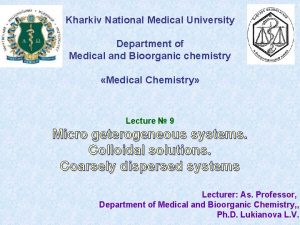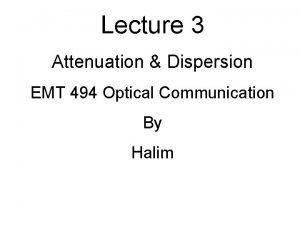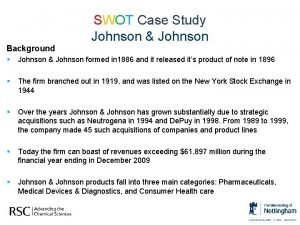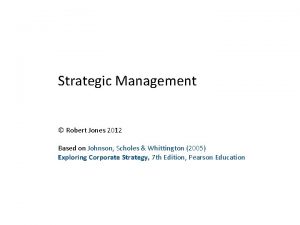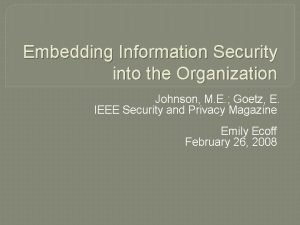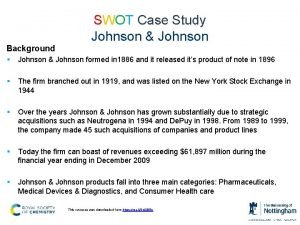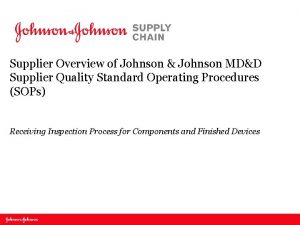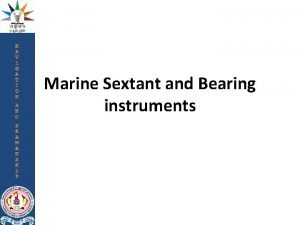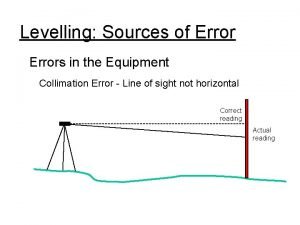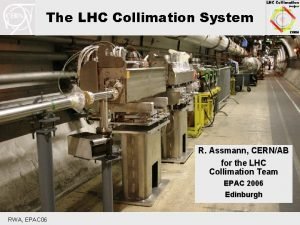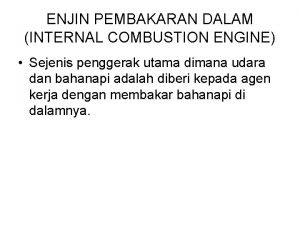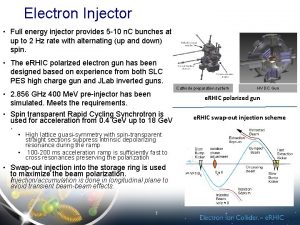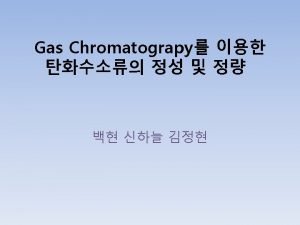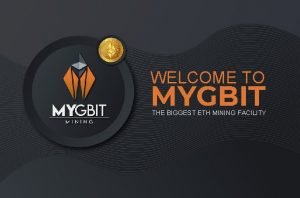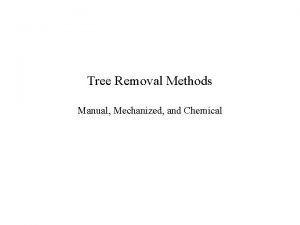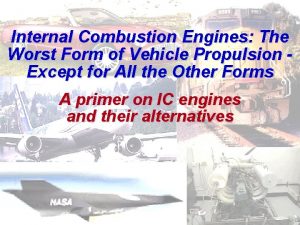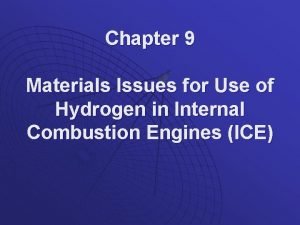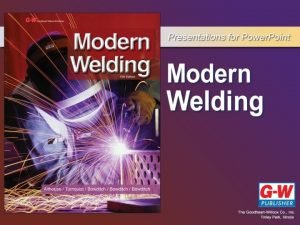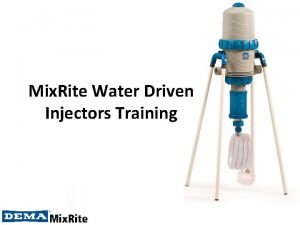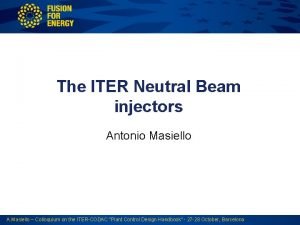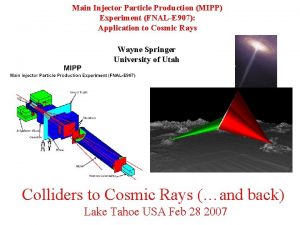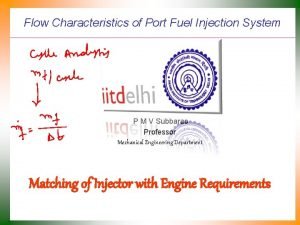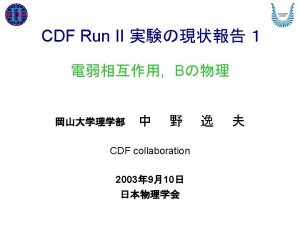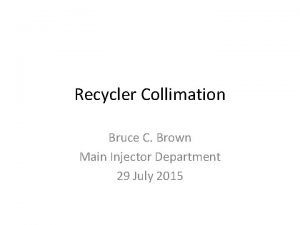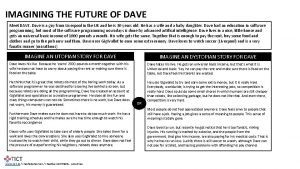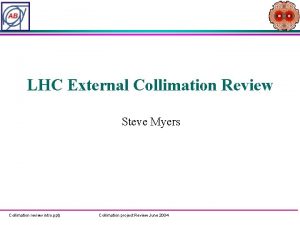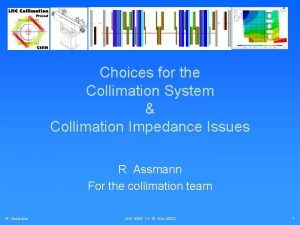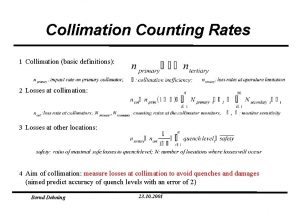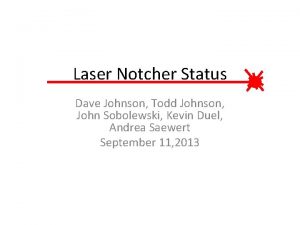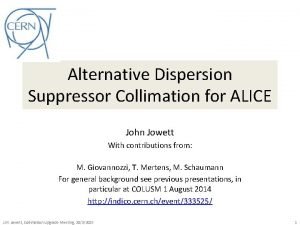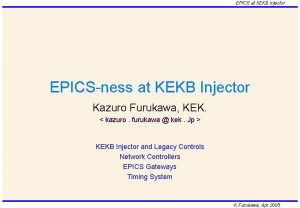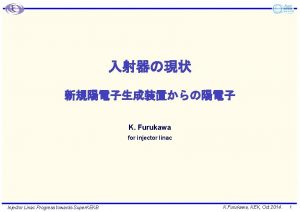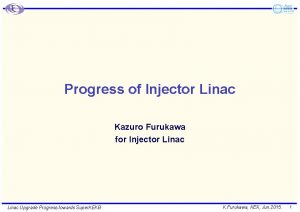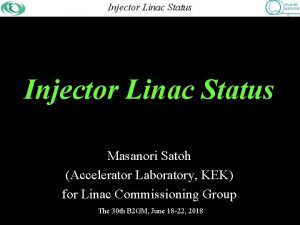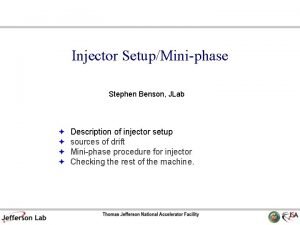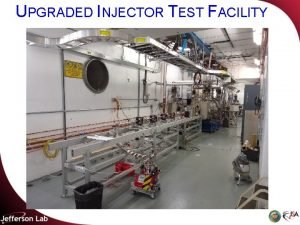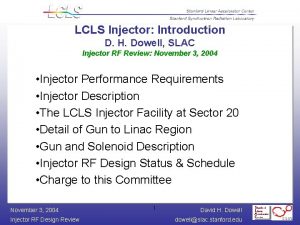Dynamic Dispersion for Main Injector Collimation Dave Johnson





























![Trim Coil and Trim Quad Currents Dispersion at Q 302 [m] CIRCUIT -0. 1 Trim Coil and Trim Quad Currents Dispersion at Q 302 [m] CIRCUIT -0. 1](https://slidetodoc.com/presentation_image_h2/0573dd5d17e81026415546e8dc2e2024/image-30.jpg)
![WAG for circuit implementation Trim Coil Count Implementation cost for MI 30 [$K] number WAG for circuit implementation Trim Coil Count Implementation cost for MI 30 [$K] number](https://slidetodoc.com/presentation_image_h2/0573dd5d17e81026415546e8dc2e2024/image-31.jpg)






- Slides: 37

Dynamic Dispersion for Main Injector Collimation Dave Johnson Review of MI Collimation Concepts June 30, 2006 DEJ Beams-doc 2315 1

Dynamic Dispersion for MI Collimation Motivation ¡ Concepts ¡ Current lattice ¡ Proposed lattice changes ¡ Impact on ECOOL ¡ Impact on RR transfers in SNu. MI Era ¡ Summary ¡ June 30, 2006 DEJ Beams-doc 2315 2

Motivation for Lattice change ¡ ¡ ¡ ¡ ¡ June 30, 2006 Although much progress has been made on increasing the efficiency of the slip stacking process and in the reduction of the Booster longitudinal emittance, we frequently have significant beam loss activating the tunnel. The situation only gets worse with slip-stacking for Nu. MI. Beam intensity increase from 8 E 12/cycle to 5. 5 E 13/cycle with Nu. MI slip-stacking (5 E 12 x 11 batches every 2. 2 sec). We need to provide a well shielded absorber to put all the beam that is not re-captured to main RF bucket. Est of 5 to 15% of injected beam (up to 5 E 12/cycle i. e. 10% of 5 E 13) Momentum collimation system-> implies the need for dispersion No room in arc’s for absorbers Room in straight sections, but dispersion is zero Need symmetric straight for dispersion un-suppression MI 10, MI 40, and MI 60 are not available but MI 30 (or at least part of) is available. What does it take ? Digress a minuet on losses (2 slides) DEJ Beams-doc 2315 3

Injection/Acceleration Efficiency Nov 05 – Mar 06 M: TOR 109/I: 14 SUM 3 90% 8 E 12 > Measure of Beam on Target/Beam at end of 8 Gev line (i. e TOR 852) ØAssume relative calibration of toroid good to about 5% > Before shutdown slip-stack ~6 -8 E 12 at efficiency of 85 to 90% on average. > After shutdown slip-stack ~5 -6 E 12 at efficiency of ~ 87% on average > After shutdown Nu. MI ran 1. 2 E 13 ish at efficiency of ~ 97 to 98% June 30, 2006 DEJ Beams-doc 2315 E: TOR 101/I: 19 SUM 3 June 06 4

Beam loss looking at BEL ¡ ¡ Plot showing TOR 852 (cyan), 14 SUM 3 (red), BEAM (blue), and the response of BEL (green). Try to keep loss to 1 k. J BEL does not include DC beam kicked into 104 and hence would report a lower loss Need to quantify differences between efficiency looking at toroids and BEL. Transition loss 1. 8 k. J/1. 6 E-19/8 Ge. V/7. 5 E 12 ~ 18% Loss of un-captured beam at start of ramp Loss due to the fuzzing of beam captured in wrong buckets AND chromatic lifetime June 30, 2006 DEJ Beams-doc 2315 5

Concept part 1 ¡ Horizontal position of a particle in a region of dispersion Motion of captured beam ¡ ¡ ramp Un-captured beam Closed orbit Locate an absorber (fixed large shielded mass) in dispersive region at a large offset Utilize corrector time/energy bump to move beam close to absorber to produce absolute aperture restriction for large amplitude particles-then u move away from absorber for remainder of cycle (reduce risk of hitting absorber with 120 Ge. V beam) n Take advantage of large step size from D*dp/dt MI 30 straight section has room in lattice for absorber (and secondary masks) so create a symmetric dispersion insert to produce the desired dispersion. (could be DC or ramped) June 30, 2006 DEJ Beams-doc 2315 6

Concept part 2 Slow loss Fast loss Slow loss 5 E 11 Start of ramp MI Ramp Integrated LM 634 ¡ ¡ ¡ June 30, 2006 Slow beam loss from start of ramp till dp/p ~. 018 Fast beam loss for dp/p >. 018 till ~. 04 (E < 9. 3 Ge. V) Another slow loss above 9. 3 Gev (chromatic effects? ) Fast loss last about 30 ms (~2, 700 turns). Time and duration of loss depends on closed orbit, proximity to aperture and momentum spread of un-captured beam. Rapid momentum change lends itself to large step size on a turn by turn basis (as compared to halo formation in Colliders) DEJ Beams-doc 2315 7

Concept 3 Measured MI momentum aperture Position change per turn At dp/p. 002 dx ~ 20 mm ¡ ¡ ¡ June 30, 2006 Momentum aperture & vertical tune for un-captured beam can generate beam loss for larger chromaticities -> want to collimate before reaching dp/p where Qy approaches ½ integer With current MI ramp dx/dt at D=2 m when dp/p <. 005 is ~10 um/turn at dp/p ~. 01 dx/dt ~16 -18 um/turn Compare with Halo collimation in Colliders where difusion rate is ~ 1 -2 um/sec ! DEJ Beams-doc 2315 8

Current Main Injector lattice ¡ ¡ ¡ Generate toy lattice with ideal quad lengths and no multipoles Compare geometry, lattice function and dispersion to full blown lattice - good agreement Tunes H 26. 425/ V 25. 415 cdddc MI-30 June 30, 2006 DEJ Beams-doc 2315 9

Proposed Lattice changes ¡ ¡ ¡ Ø June 30, 2006 The basic idea is to create a region of dispersion in a otherwise dispersion free region where there is room for collimator absorbers. To be done in MI 30 ! How ? Symmetrically power the trim coils in the IQC and IQD quads of the dispersion suppressors on either side of the MI 30 straight section Add trim quads in the MI 30 straight section and power them symmetrically around Q 305 This solution introduces a tune shift which must be compensated by main QF and QD quad bus The trim coils in IQC and IQD in remainder of ring are adjusted to minimize lattice function distortion. Use MAD to generate insert, match to existing ring lattice and adjust ring tune. Next 8 slides show solutions from current to final solution DEJ Beams-doc 2315 10

Current Lattice -- Ring Dispersion • Proton direction • MAD uses RHR • +X to ring inside • B fix, D<0, p<p 0, dx>0 (inside) • Dispersion suppressors not matched between arc and SS (in dispersion or beta) • The next seven slides will show the dispersion ramp from its current level to where it is -2. 2 m at Q 302 and Q 308 June 30, 2006 MI-30 DEJ Beams-doc 2315 11

DEJ Beams doc 2315, June 30, 2006 Ramping Dispersion -0. 2 m June 30, 2006 DEJ Beams-doc 2315 12

Ramping Dispersion -0. 4 m June 30, 2006 DEJ Beams-doc 2315 13

Ramping Dispersion -0. 6 m June 30, 2006 DEJ Beams-doc 2315 14

Ramping Dispersion -1. 0 m June 30, 2006 DEJ Beams-doc 2315 15

Ramping Dispersion -1. 2 m June 30, 2006 DEJ Beams-doc 2315 16

Ramping Dispersion -1. 6 m June 30, 2006 DEJ Beams-doc 2315 17

Ramping Dispersion -2. 2 m June 30, 2006 DEJ Beams-doc 2315 18

Dispersion in MI 30 for -2. 2 m Solution ¡ ¡ ¡ Close up view of MI 30 dispersion Note the zero dispersion at 22 and 32 Note symmetric solution Dp/p <0 move radial in Particles with dp/p >0 move radial out (collimate high momentum at 308? ) June 30, 2006 Q 302 DEJ Beams-doc 2315 Q 308 19

Lattice functions of Current MI • Proton direction • Lattice with ideal quad length • Vertical beta wave measured in machine • The next seven slides will show the beta fctn while ramping the dispersion to where it is -2. 2 m at Q 302 and Q 308 June 30, 2006 DEJ Beams-doc 2315 20

Lattice with Dispersion -0. 2 m June 30, 2006 DEJ Beams-doc 2315 21

Lattice with Dispersion -0. 4 m June 30, 2006 DEJ Beams-doc 2315 22

Lattice with Dispersion -0. 6 m June 30, 2006 DEJ Beams-doc 2315 23

Lattice with Dispersion -1. 0 m June 30, 2006 DEJ Beams-doc 2315 24

Lattice with Dispersion -1. 2 m June 30, 2006 DEJ Beams-doc 2315 25

Lattice with Dispersion -1. 6 m June 30, 2006 DEJ Beams-doc 2315 26

Lattice with Dispersion -2. 2 m June 30, 2006 DEJ Beams-doc 2315 27

Procedure for creating insert ¡ Create Dispersion Insert l l l ¡ Compensate phase shift & maintain match to ring l ¡ Beam line between 228 and 314 Constrain Dx, D’x at 302 and 308 Match b and D (and their derivatives in both planes) at 314 cell bndry to existing ring lattice functions. Constrain max b between 228 &314 Vary 5 trim coils & 4 trim quads Generates insert & phase shift Use Main quad bus & trim coils in each dispersion suppressor in 4 circuits IQC(F&D) and IQD(F&D) Re-tune machine to desired tune l June 30, 2006 Use main quad circuits QF & QD DEJ Beams-doc 2315 28

Power Supply settings June 30, 2006 DEJ Beams-doc 2315 29
![Trim Coil and Trim Quad Currents Dispersion at Q 302 m CIRCUIT 0 1 Trim Coil and Trim Quad Currents Dispersion at Q 302 [m] CIRCUIT -0. 1](https://slidetodoc.com/presentation_image_h2/0573dd5d17e81026415546e8dc2e2024/image-30.jpg)
Trim Coil and Trim Quad Currents Dispersion at Q 302 [m] CIRCUIT -0. 1 -0. 2 -0. 4 -0. 6 -0. 8 -1 -1. 2 -1. 6 -2 -2. 2 Trim quads in 30 straight section QT 305 -3. 4226 5. 5243 6. 1802 10. 5128 10. 9051 9. 7117 5. 7504 -2. 5358 -3. 0221 -2. 4953 QT 304/QT 306 4. 2817 2. 2994 2. 7779 -1. 7600 -2. 5590 -2. 0001 2. 4856 9. 2143 9. 5477 10. 5687 QT 303/QT 307 -0. 7174 6. 2193 7. 0260 9. 3411 9. 1993 8. 0247 6. 8826 3. 7119 -1. 1026 -0. 9487 QT 302/QT 308 -1. 8418 -1. 4830 -0. 0625 1. 4433 1. 6130 0. 5093 -1. 7543 -2. 7585 -6. 3698 -7. 3141 MI 30 dispersion suppressor trim coils 301/309 (IQC) 5. 4555 -0. 4790 -0. 7752 -1. 3652 -1. 1058 -0. 7443 0. 0810 1. 3991 12. 3179 13. 2130 232/310 (IQD) -2. 3953 -0. 6305 -2. 5857 -3. 5599 -5. 3711 -6. 8352 -8. 0947 -10. 2664 -1. 5507 -16. 3284 231/311(IQD) -1. 4622 -7. 1731 -8. 2051 -10. 3488 -9. 6639 -8. 1818 -7. 2887 -4. 7833 1. 3337 1. 4421 230/312(IQD) 11. 1522 0. 5916 -0. 0642 -1. 2021 -2. 9531 -4. 2409 -5. 1369 -7. 0027 -7. 8471 -8. 3332 229/313(IQC) -5. 2887 -2. 1923 -1. 8171 -2. 2105 -1. 8332 -1. 4997 -1. 2096 -0. 1809 -8. 4197 -9. 0011 Ring dispersion suppressor trim coils IQCF 6. 1437 6. 1411 6. 1735 6. 1772 6. 6830 6. 2029 6. 2009 6. 1926 6. 1794 6. 1955 IQCD -6. 1141 -6. 1135 -6. 1307 -6. 1413 -6. 1431 -6. 1387 -6. 1362 -6. 1365 -6. 1385 -6. 1392 IQDF 6. 1250 6. 1218 6. 1354 6. 1320 6. 6328 6. 1608 6. 1561 6. 1409 6. 1258 6. 1540 IQDD -6. 0511 -6. 0505 -6. 0675 -6. 0781 -6. 0798 -6. 0754 -6. 0730 -6. 0733 -6. 0752 -6. 0760 June 30, 2006 DEJ Beams-doc 2315 30
![WAG for circuit implementation Trim Coil Count Implementation cost for MI 30 K number WAG for circuit implementation Trim Coil Count Implementation cost for MI 30 [$K] number](https://slidetodoc.com/presentation_image_h2/0573dd5d17e81026415546e8dc2e2024/image-31.jpg)
WAG for circuit implementation Trim Coil Count Implementation cost for MI 30 [$K] number of quad circuits 4 number of trim coil circuits 5 unit cost circuit quad power supply $2. 5 $10. 0 trim coil power supply+ cable $2. 5 $10. 0 bulk supply (? ) Implementation costs for ring trim coils [$K] unit cost power supply+cable bulk (1/house) breaker TOTALS June 30, 2006 $2. 0 $34. 5 breaker (1/house) TOTALS DEJ Beams-doc 2315 indivdual circuits $2. 5 $175. 0 $60. 0 $10. 0 $70. 0 $2. 0 $14. 0 $259. 0 $144. 0 31

Potential MI 30 layout V 303 K H 302 H 304 Q 305 Vertical collimator/absorber Horizontal collimator/absorber Secondary mask (outside beam pipe) ¡ ¡ ¡ ¡ June 30, 2006 Kicker 309 ECOOL Lam 308 V 301 H 308 Utilize combination of fixed absorbers and masks Install Vertical absorber ds Q 303 Install Horizontal absorber ds Q 302 Replace Q 302 and Q 303 with IQE or WQB Move QXR quad at Q 302 to Q 306 Future potential RR->MI transfer line devices (in red) Could utilize kicker at Q 301 to remove beam in kicker gap DEJ Beams-doc 2315 32

Concept on fixed absorber beam Top view (tapered end) Cross section ¡ ¡ ¡ Corrector moves beam to be collimated Both cross sections are shown on single plot Vertical (red) has W jaw on top Horizontal (magenta) has W jaw radial inside Absorber jaw tapered to improve impact parameter Absorber on MI like stands and surveyed into position (reduce cost and complexity of absorber) June 30, 2006 DEJ Beams-doc 2315 33

Compatibility with MI-RR Pbar Transfers ¡ ¡ ¡ Beam centroid on pbar transfers to RR is about 10 mm at 302 and 16 mm at 230. Absorber edge at offset > 25 mm Use correctors to move beam close as necessary to absorber to maximize impact parameter June 30, 2006 DEJ Beams-doc 2315 34

Impact on ECOOL ¡ ¡ ¡ June 30, 2006 Want to minimize prompt radiation in the ECOOL region. Design of a mask (steel outside the beam pipe in a region of loss) for Q 301 has been done (by Nikolai using MARS) for a loss rate of 3 E 9 p/s at a grazing angle. Single mask reduce prompt dose at ECOOL by factor 15 over no mask. (e-mail 9/2/05). Addition of second mask at 305 reduced rate by another factor of 5. With the absorber at 302 and 303 and masks at 304 and 305. We should be able to keep all activation within this region. This needs verification ! DEJ Beams-doc 2315 35

Impact on RR transfers in SNu. Mi Era ¡ e 25 p s. H ~5 mm s. V ~3 mm sp/p ~4 E-4 & D 2 m ->. 8 mm ¡ ¡ Use WQB at Q 308 Offset Lambertson septa by ~1520 mm Inject with zero dispersion, capture then ramp the dispersion insert (dynamic) in ~ 20 -40 ms Minimal impact on transfer line design DC insert -> larger impact RR VLAM RR-30 straight section 309 308 306 304 K June 30, 2006 309 308 K 306 K VUP 1 VDN 2 MI-30 straight section 302 HKICK at MRK 232 304 302 K MI VLAM Rolled DEJ Beams-doc 2315 36

Summary ¡ ¡ ¡ June 30, 2006 It has been shown that a dynamic dispersion insert to generate 2. 2 m of dispersion in the MI 30 straight is feasible with minimal impact on lattice or dispersion in the remainder of the ring. A single fixed absorber concept is utilized due to large particle step size (does not require 2 stage collimation) A Potential layout and MI 30 modifications is outlined Impact on ECOOL and SNu. MI Era transfer line looks to be minimal WAG cost est. for power supplies was presented Other concepts for matching should be investigated such as phase trombone in MI 60. DEJ Beams-doc 2315 37
 Dispersed phase and dispersion medium
Dispersed phase and dispersion medium Kinetic properties of colloids
Kinetic properties of colloids In which type of fibers intermodel dispersion loss occurs
In which type of fibers intermodel dispersion loss occurs Johnson & johnson swot
Johnson & johnson swot Johnson and johnson bcg matrix
Johnson and johnson bcg matrix Laurie johnson brad johnson
Laurie johnson brad johnson Ethical decision making
Ethical decision making Johnson and johnson organizational structure
Johnson and johnson organizational structure Understanding the mirai botnet
Understanding the mirai botnet Swot johnson and johnson
Swot johnson and johnson Jjeds johnson
Jjeds johnson Johnson and johnson three c's of classroom management
Johnson and johnson three c's of classroom management Johnson and johnson md&d
Johnson and johnson md&d Marine sextant
Marine sextant Errors in levelling
Errors in levelling Star testing astronomical telescopes
Star testing astronomical telescopes And a modular collimation system
And a modular collimation system Keburukan injector cleaner
Keburukan injector cleaner Electron injector
Electron injector Light vehicle diesel engines
Light vehicle diesel engines Split/splitless injector
Split/splitless injector Kioritz soil injector
Kioritz soil injector Mgbit
Mgbit Hypo hatchet tree injector
Hypo hatchet tree injector Mazzei injector selector
Mazzei injector selector Lbz injector balance rates
Lbz injector balance rates Uuu injector
Uuu injector Pressure regulator
Pressure regulator What causes a bell mouthed kerf
What causes a bell mouthed kerf Cana auto injector
Cana auto injector Mix rite injectors
Mix rite injectors Michigan ffa skills contest
Michigan ffa skills contest Antonio masiello
Antonio masiello Cana injector
Cana injector Oxy blast well injector
Oxy blast well injector Fnale
Fnale Mars injector
Mars injector Weber number
Weber number
